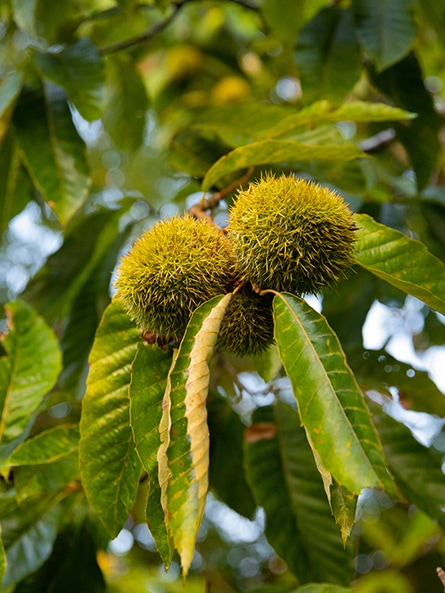Landscaping With PQK Chestnut Tree
Castanea dentata 'PQK' (PQK Chestnut Tree) has its North American origins in the forests where it dominated the landscape of the eastern United States long ago. For centuries this tree served as an essential element to both natural environments and human societies because it provided food as well as timber and medicinal resources. Indigenous populations honored this species due to its resilient character and abundant yield and used its products both for survival and commercial purposes.
European settlers acknowledged its substantial worth and utilized it for building purposes and cooking needs while also burning it as fuel. Early American infrastructure relied heavily on wood because of its durable nature and its ability to resist decay. The species now faces critical preservation needs due to its dramatically reduced presence in wild areas, which has resulted from challenges throughout the last hundred years.
PQK Chestnut Tree Medicinal Uses Through the Ages
Castanea dentata 'PQK' gained recognition for its medicinal qualities straight after its discovery. Early herbalists together with Native American tribes used the bark and leaves extensively to prepare teas and tinctures which people believed helped treat different medical conditions. The bark's tannins established it as a popular treatment for throat pain as well as digestive disorders and skin problems.
People commonly applied poultices made from leaves to minimize swelling and inflammation while they utilized inner bark decoctions to treat fevers and respiratory infections. Modern herbalists continue to utilize its extracts for inflammatory disorders as part of a generational tradition that persists today.

Discovery and First Documentation
Early colonial explorers first documented Castanea dentata 'PQK' when naturalists observed this species' extensive distribution throughout woodland areas. The species' abundant presence became a vital component of early farming economies because both settlers and scientists found its resilience and fast growth remarkable.
The tree received extensive study and classification from 18th and 19th-century botanists who acknowledged its remarkable adaptability and economic significance. Its recognition expanded beyond landscape importance as researchers discovered its distinctive characteristics which also sparked scientific interest.
A Valuable Addition to Landscapes
PQK Chestnut Tree stands out as an ideal selection for large-scale landscaping projects within cultivated settings. The tree's majestic height establishes it as a prominent feature throughout parks, estates, and conservation areas. The tree thrives in diverse soil environments and grows quickly which makes it an excellent option for people who want to restore native landscapes or incorporate historical elements into their gardens.
The dense canopy of this tree generates plenty of shade which makes it perfect for use in avenues and open spaces that require cooling effects. The tree's leaves showcase stunning seasonal transformations from deep green shades during the summer months to warm golden tones in the fall. It stands out as a stunning centerpiece in any outdoor area whether planted alone to showcase its magnificence or in clusters to simulate woodland surroundings.
PQK Chestnut Tree A Striking Appearance
Castanea dentata 'PQK' stands upright with great dignity while displaying a noble and stately appearance. The tree's expansive crown creates an elegant outline against the sky and its deeply ridged bark gives it an appearance of maturity and power. The tree's serrated lance-shaped leaves display a bright green color throughout the growing period which transforms into a golden-bronze display as autumn arrives.
During late spring and early summer the tree develops long flowers resembling catkins which release a gentle scent drawing pollinators from distant areas. As the year advances the tree produces its prized nut-filled burrs which are shielded by protective spiny husks. The combination of these features results in a tree that stands out for its majestic presence while maintaining ecological importance and providing visual interest all year long.
A Sanctuary for Rare Wildlife
Beyond its visual charm PQK Chestnut Tree serves as an essential habitat for many wildlife species including those that are rare and endangered. Native bees and butterflies find essential nectar from these flowers which sustains a healthy community of beneficial insects.
Many mammals including deer, squirrels and bears depend on the nuts from this tree as their essential food supply during winter months. Numerous bird species including wild turkeys and blue jays actively seek these nuts because they provide a rich source of energy. The thick foliage creates ideal nesting spots and protective shelter for various bird and small mammal species which highlights its importance as a keystone tree in the ecosystem.
PQK Chestnut Tree Strength and Hardiness
Resilience defines Castanea dentata 'PQK'. This tree species thrives across multiple soil types including loamy and well-drained soils as well as acidic and rocky conditions. This species exhibits outstanding cold tolerance which enables it to survive harsh winters without losing its structural stability through seasonal changes.
The tree's deep-rooted structure defends against powerful winds and prevents soil erosion, making it highly suitable for landscape stabilization. When optimal conditions prevail this species establishes itself rapidly and performs well in both urban and rural settings. The tree's durable nature allows it to stay as a permanent fixture while bolstering biodiversity and sustainability in cultivated regions.
Conclusion
The extraordinary PQK Chestnut Tree demonstrates nature's capacity for endurance through its historical importance, medicinal properties, stunning appearance and ecological value.